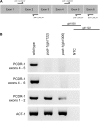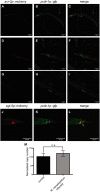Identification of a Conserved, Orphan G Protein-Coupled Receptor Required for Efficient Pathogen Clearance in Caenorhabditis elegans
- PMID: 30692178
- PMCID: PMC6434109
- DOI: 10.1128/IAI.00034-19
Identification of a Conserved, Orphan G Protein-Coupled Receptor Required for Efficient Pathogen Clearance in Caenorhabditis elegans
Abstract
G protein-coupled receptors contribute to host defense across the animal kingdom, transducing many signals involved in both vertebrate and invertebrate immune responses. While it has become well established that the nematode worm Caenorhabditis elegans triggers innate immune responses following infection with numerous bacterial, fungal, and viral pathogens, the mechanisms by which C. elegans recognizes these pathogens have remained somewhat more elusive. C. elegans G protein-coupled receptors have been implicated in recognizing pathogen-associated damage and activating downstream host immune responses. Here we identify and characterize a novel G protein-coupled receptor required to regulate the C. elegans response to infection with Microbacterium nematophilum We show that this receptor, which we designate pathogen clearance-defective receptor 1 (PCDR-1), is required for efficient pathogen clearance following infection. PCDR-1 acts upstream of multiple G proteins, including the C. elegans Gαq ortholog, EGL-30, in rectal epithelial cells to promote pathogen clearance via a novel mechanism.
Keywords: Caenorhabditis elegans; G protein-coupled receptor; Microbacterium nematophilum; pathogen clearance.
Copyright © 2019 American Society for Microbiology.
Figures








Similar articles
-
Activation of a G protein-coupled receptor by its endogenous ligand triggers the innate immune response of Caenorhabditis elegans.Nat Immunol. 2014 Sep;15(9):833-8. doi: 10.1038/ni.2957. Epub 2014 Aug 3. Nat Immunol. 2014. PMID: 25086774 Free PMC article.
-
Octopaminergic Signaling Mediates Neural Regulation of Innate Immunity in Caenorhabditis elegans.mBio. 2018 Oct 9;9(5):e01645-18. doi: 10.1128/mBio.01645-18. mBio. 2018. PMID: 30301853 Free PMC article.
-
Identification and Functional Analysis of Cytokine-Like Protein CLEC-47 in Caenorhabditis elegans.mBio. 2021 Oct 26;12(5):e0257921. doi: 10.1128/mBio.02579-21. Epub 2021 Oct 12. mBio. 2021. PMID: 34634942 Free PMC article.
-
Strength in numbers: "Omics" studies of C. elegans innate immunity.Virulence. 2012 Oct 1;3(6):477-84. doi: 10.4161/viru.21906. Epub 2012 Oct 1. Virulence. 2012. PMID: 23076279 Free PMC article. Review.
-
Detection of Pathogens and Regulation of Immunity by the Caenorhabditis elegans Nervous System.mBio. 2021 Mar 30;12(2):e02301-20. doi: 10.1128/mBio.02301-20. mBio. 2021. PMID: 33785621 Free PMC article. Review.
Cited by
-
Innate immunity in C. elegans.Curr Top Dev Biol. 2021;144:309-351. doi: 10.1016/bs.ctdb.2020.12.007. Epub 2021 Mar 4. Curr Top Dev Biol. 2021. PMID: 33992157 Free PMC article. Review.
-
Phylum-Spanning Neuropeptide GPCR Identification and Prioritization: Shaping Drug Target Discovery Pipelines for Nematode Parasite Control.Front Endocrinol (Lausanne). 2021 Sep 30;12:718363. doi: 10.3389/fendo.2021.718363. eCollection 2021. Front Endocrinol (Lausanne). 2021. PMID: 34659113 Free PMC article.
-
Similarities in the induction of the intracellular pathogen response in Caenorhabditis elegans and the type I interferon response in mammals.Bioessays. 2023 Nov;45(11):e2300097. doi: 10.1002/bies.202300097. Epub 2023 Sep 4. Bioessays. 2023. PMID: 37667453 Free PMC article.
-
Melatonin promotes sleep by activating the BK channel in C. elegans.Proc Natl Acad Sci U S A. 2020 Oct 6;117(40):25128-25137. doi: 10.1073/pnas.2010928117. Epub 2020 Sep 21. Proc Natl Acad Sci U S A. 2020. PMID: 32958651 Free PMC article.
-
G protein-coupled receptors: The choreographers of innate immunity in Caenorhabditis elegans.PLoS Pathog. 2021 Jan 21;17(1):e1009151. doi: 10.1371/journal.ppat.1009151. eCollection 2021 Jan. PLoS Pathog. 2021. PMID: 33476324 Free PMC article. Review. No abstract available.
References
Publication types
MeSH terms
Substances
Grants and funding
LinkOut - more resources
Full Text Sources

